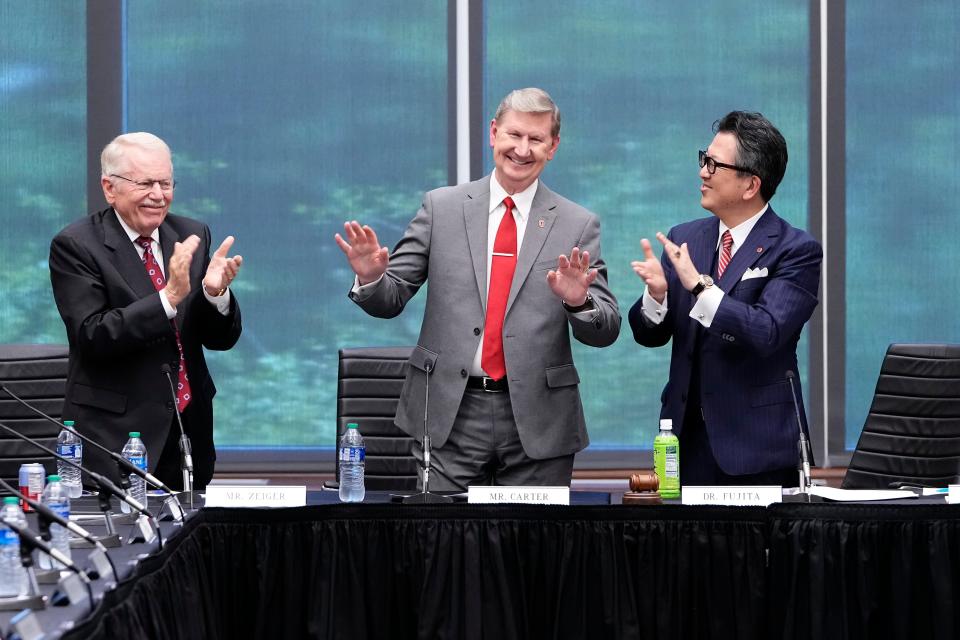Does OSU's new president deserve to make more than most Ohioans will earn in lifetime| Expert
- Oops!Something went wrong.Please try again later.
James Finkelstein is professor emeritus of public policy and Judith Wilde is research professor in the Schar School of Policy and Government at George Mason University. Finkelstein received his graduate degrees from Ohio State.
According to The Chronicle of Higher Education's recent report on compensation for public university presidents, incoming Ohio State president Ted Carter's base pay, as reported by the Columbus Dispatch, of $1.1 million will likely rank him among the top three in the nation, not including presidents of state-wide systems.
But his annual base pay tells less than half of the story.
The Dispatch graciously provided us with a copy of Carter's appointment letter. We estimate its value, across the 5-year contract, to be more than $12.6 million.
It is the wealthiest contract we've seen in the 20 years we've studied public university presidents' contracts.
New Ohio State president Q&A: He almost didn't take the job, Intel, the Wexners and more
More: Here's everything to know about Ohio State's new president Walter ‘Ted’ Carter Jr.
What does the contract tell us?

Assuming Carter completes his full contract, here is our analysis:
His base salary, including an estimated annual raise of 4 percent, will total just under $6 million. The standard university fringe benefits (health insurance, retirement, etc.) add another $1.6 million.
If he achieves the goals set by the board each year, he will receive bonuses totaling more than $2 million, possibly more.
He gets an annual "allowance" of $50,000, for a total of $250,000.
The university will contribute $1.5 million to a supplemental retirement program.
The university will pay $1.25 million in premiums for a whole life insurance policy that he will own.
He was given $45,000 to cover moving expenses.
James Finkelstein and Judith Wilde: If Kristina Johnson 'resigned' why is Ohio State going to keep paying her?
In addition, the university will pay for memberships in a country club and a social club, provide the Carters with a rent-free mansion in Bexley, and guarantee certain post-presidential perks.
We acknowledge that Carter is a proven leader. He had a distinguished career as a military aviator and leader, rising to the rank of vice admiral.
More: Next Ohio State president Ted Carter will make millions in pay and job perks
During his service in the U.S. Navy, he led both the Naval War College and the U.S. Naval Academy.
By all accounts, he was a highly regarded and successful University of Nebraska system president. And based on this contract, he is a highly skilled negotiator.
But all of this begs an important question: Why are today's university presidents so highly compensated? In one of our recent studies, we found that in 2010, "on average, a [public] flagship university president was paid $543,000 (adjusted for inflation) in reportable income; 10 years later [2019], the average was $715,000 — an increase that outpaced inflation by nearly 32 percent." By contrast, across that same 2009-to-2019 time period, "full professors’ adjusted salaries at flagship universities have barely outpaced inflation, rising by an average of $646 per professor."

There is no question that Ohio State is a large and complex organization. With a budget exceeding $9B, Ohio State employs more than 50,000 individuals and enrolls over 65,000 students. But, the US Navy also is a large and complex organization.
With a budget of $162.9B in 2021, it employs about 340,000 personnel. Still, the chief of naval operations is a 4-star admiral paid less than $215,000 annually.
While both are government employees with substantial responsibilities, one is paid as a public servant, and the other is compensated like a private corporation’s CEO. However, we note that a public university president is not the CEO of a corporation; they are the leaders of public agencies.
Today, many families struggle to pay the cost of college, even for public universities such as Ohio State. They are investing in the future — the future for their families or themselves.
It makes us wonder if the taxpayers of Ohio and Ohio State's students and donors are making a smart investment in agreeing to pay more than most Ohioans earn in their lifetimes to just one individual over the next five years.
We are all grateful to Mr. Carter for his service to our country. More than most, he understands the sacrifice it takes to make America strong and prosperous. It is a shame that his financial success comes at a cost to the rest of us.
James Finkelstein is professor emeritus of public policy and Judith Wilde is research professor in the Schar School of Policy and Government at George Mason University. Finkelstein received his graduate degrees from Ohio State.
This article originally appeared on The Columbus Dispatch: How much does Ted Carter, OSU's new president, make?

